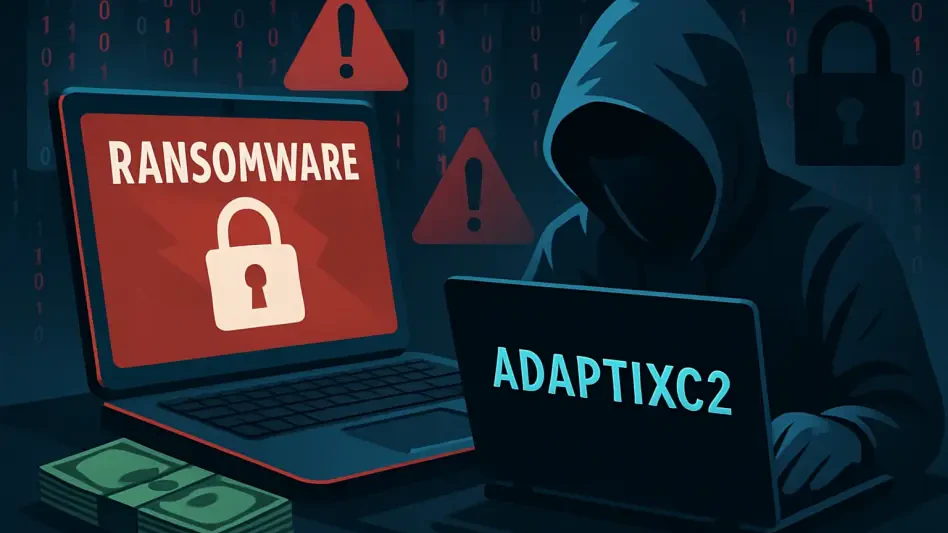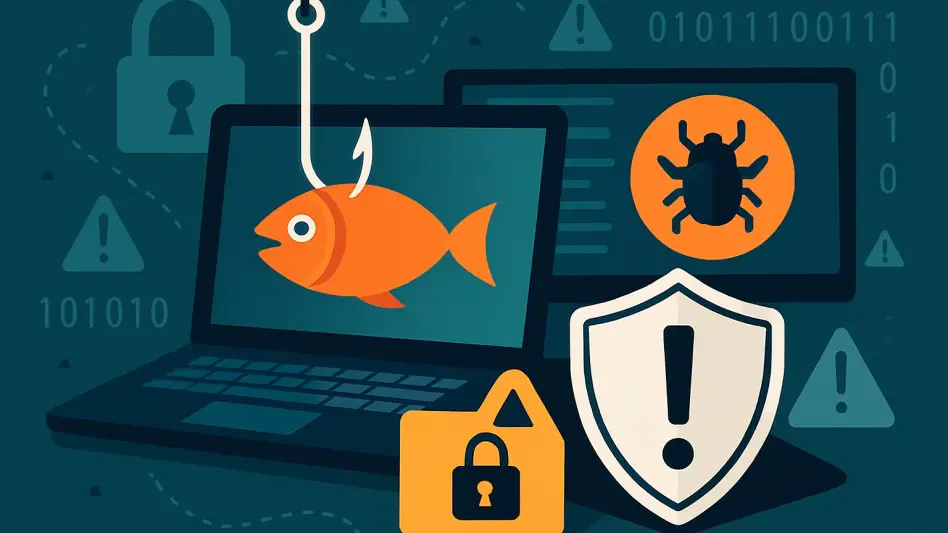The cybersecurity landscape in 2025 faces an escalating crisis as ransomware attacks grow more sophisticated, with threat actors weaponizing legitimate tools for malicious gain, creating a pressing need for advanced defense strategies. One alarming statistic stands out: ransomware groups have extorted millions from organizations worldwide, with a single Akira affiliate reportedly amassing $42 million from over 250 victims. At the heart of this surge lies AdaptixC2, an adversarial emulation framework originally crafted for ethical security testing, now repurposed for post-exploitation in devastating campaigns. This roundup dives into diverse perspectives from industry experts, researchers, and security analysts to unpack how AdaptixC2 has become a favored tool among cybercriminals, the challenges it poses to global defenses, and actionable strategies to counter this evolving threat.
Diverse Views on the Rise of AdaptixC2 in Cybercrime
Security researchers have sounded the alarm on the misuse of AdaptixC2, noting its transformation from a penetration testing asset to a ransomware enabler. Many emphasize that its Golang-based server and cross-platform GUI, built with C++ and QT, offer cybercriminals a robust platform for evading detection. A recurring observation is the tool’s surge in malicious use following the release of new detection signatures, highlighting how quickly threat actors adapt to countermeasures.
Contrasting opinions emerge on the inherent risks of dual-use frameworks like AdaptixC2. Some industry voices argue that the accessibility of open-source tools inevitably fuels cybercrime, as malicious actors exploit these resources with minimal barriers. Others contend that the responsibility lies not with the tools themselves but with inadequate oversight and a lack of stringent controls over their distribution, sparking a broader debate on balancing innovation with security.
A third perspective focuses on the scale of the threat, particularly in ransomware operations targeting critical infrastructure across Europe, North America, and Australia. Analysts point out that groups like the Akira affiliate leverage AdaptixC2 to streamline post-exploitation activities, amplifying the efficiency of their attacks. This viewpoint underscores a pressing need for global cooperation to address the misuse of legitimate frameworks before further damage unfolds.
Expert Opinions on Exploitation Tactics and Real-World Impact
From Testing Tool to Ransomware Weapon
Industry insights reveal a stark shift in AdaptixC2’s role, with many experts detailing how its features have been repurposed for malicious payloads. The tool’s ability to operate across multiple platforms makes it an attractive choice for cybercriminals orchestrating complex ransomware schemes. This adaptability, once a strength for ethical testers, now poses a significant hurdle for traditional security mechanisms.
Another angle comes from threat intelligence teams who link AdaptixC2 to specific malware loaders like CountLoader, identified in recent campaigns starting in 2025. These connections illustrate how ransomware operators integrate the framework into their attack chains, using it to maintain persistence and control over compromised systems. Such tactics have reportedly contributed to breaches affecting hundreds of organizations globally.
A differing take focuses on the ethical dilemma surrounding dual-use technologies. Some cybersecurity professionals argue that while AdaptixC2’s misuse is alarming, banning or restricting such tools could stifle legitimate security research. This perspective calls for a nuanced approach, suggesting that enhanced monitoring and user accountability might mitigate risks without curbing innovation.
Specific Campaigns and Their Fallout
Analysts tracking ransomware trends highlight how AdaptixC2 empowers groups to target high-value sectors with precision. Reports indicate that campaigns in regions like North America and Europe often focus on critical infrastructure, where downtime translates to massive financial and societal costs. The ability of threat actors to bypass conventional defenses using this tool has led to widespread concern among industry watchers.
A contrasting opinion emerges from incident response specialists who note the amplified challenges in mitigating these attacks. They describe how AdaptixC2’s integration into ransomware operations complicates recovery efforts, as attackers can quickly pivot tactics mid-campaign. This adaptability often leaves organizations struggling to restore systems while under pressure from ransom demands.
Some experts also weigh in on the broader implications, pointing out that the financial success of groups like the Akira affiliate—raking in millions—encourages other cybercriminals to adopt similar tools. This snowball effect threatens to escalate the ransomware epidemic, prompting calls for urgent updates to detection frameworks and response protocols to keep pace with evolving strategies.
Trends and Geopolitical Concerns
Recent analyses spotlight emerging patterns in AdaptixC2’s adoption, with many noting a spike in usage among ransomware operators after detection mechanisms were updated. Some researchers suggest a possible connection to Russian-language online communities where the tool is promoted, raising questions about cultural or regional influences on cybercriminal behavior. These observations fuel speculation about the geopolitical dimensions of such threats.
Differing views arise on the potential involvement of state-aligned actors. While no concrete evidence links AdaptixC2 misuse to specific governments, certain experts argue that the sophistication and targeting patterns hint at indirect support or tolerance from certain regions. Others caution against premature conclusions, stressing that cybercrime often transcends borders and political motives, making attribution a persistent challenge.
A third perspective emphasizes the need to anticipate future escalations. Analysts warn that as more threat actors adopt frameworks like AdaptixC2, attack volumes could surge, potentially disrupting global economies. This concern drives a push for international policies to address the proliferation of offensive tools, alongside efforts to educate organizations on emerging risks.
Developer Ties and Attribution Challenges
Insights into AdaptixC2’s origins reveal ambiguity around its primary developer, known by the alias “RalfHacker.” Many in the cybersecurity field express concern over ties to hacking forums and ambiguous labels like “MalDev” on public profiles, as flagged by research teams. While direct involvement in attacks remains unproven, these connections prompt scrutiny of the developer’s role in the tool’s misuse.
A contrasting opinion focuses on the broader issue of developer accountability. Some industry leaders argue that creators of dual-use tools should face stricter ethical guidelines, especially when their work intersects with criminal ecosystems. Others defend the right to develop such frameworks, asserting that misuse is a downstream problem unrelated to original intent, complicating the attribution debate.
Further analysis highlights the inherent difficulties in pinpointing responsibility in cyberspace. Experts note that threat actors often hide behind layers of anonymity, making it nearly impossible to draw definitive links between developers and malicious campaigns. This uncertainty reinforces the need for continuous monitoring of suspicious activities tied to tools like AdaptixC2, rather than relying solely on attribution efforts.
Strategies to Counter AdaptixC2-Driven Threats
Security professionals offer a range of tips to fortify defenses against AdaptixC2 misuse. A common recommendation is for organizations to monitor network traffic for connections to known AdaptixC2 servers, as this can serve as an early indicator of compromise. Integrating such checks into existing threat detection systems is seen as a practical first step by many analysts.
Another strategy gaining traction involves tracking specific malware precursors like CountLoader, which has been tied to AdaptixC2 in recent attacks. Experts advise security teams to prioritize alerts on unusual Golang-based command-and-control communications, as well as unknown C++ QT applications across Windows, macOS, and Linux environments. These measures aim to disrupt attack chains before they escalate.
A final piece of advice centers on fostering a proactive cybersecurity culture. Some thought leaders stress the importance of regular training for IT staff to recognize emerging threats, alongside investments in adaptive technologies. By combining technical safeguards with human vigilance, organizations can better shield themselves from the sophisticated tactics enabled by tools like AdaptixC2.
Reflecting on a Unified Path Forward
Looking back, the discussions and insights gathered from various cybersecurity experts paint a vivid picture of the challenges posed by AdaptixC2’s exploitation in ransomware attacks. The diverse perspectives underscore a shared urgency to address the misuse of legitimate tools, while highlighting the complexities of attribution and ethical boundaries in this domain. Moving forward, organizations must prioritize the adoption of recommended detection strategies, such as monitoring specific indicators and enhancing threat intelligence capabilities. Beyond immediate defenses, fostering collaboration across industries and borders to establish clearer guidelines for dual-use frameworks remains essential. As the cybercrime landscape continues to evolve, staying proactive with innovative solutions and shared knowledge will be key to outmaneuvering adaptive threats.








